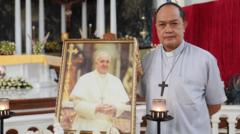Black smoke rising from the Sistine Chapel chimney indicates that the conclave, tasked with electing a new pope, still has not reached a consensus after its initial votes, prompting speculation about the ongoing selection process.
**Cardinals Fail to Elect Pope as Black Smoke Signals Inconclusive Voting**

**Cardinals Fail to Elect Pope as Black Smoke Signals Inconclusive Voting**
**St. Peter’s Square Holds Collective Breath for New Pope Amidst Black Smoke Signaling Continued Inconclusiveness**
The atmosphere in Vatican City was tense on Thursday morning as black smoke billowed from the chimney atop the Sistine Chapel, marking the second day of voting among the 133 cardinal electors tasked with choosing the next pope. The crowd gathered in St. Peter's Square expressed disappointment as the morning ballots failed to produce a consensus.
The waiting period has already worn on for many, especially since it is the first conclave in over a decade following Pope Francis' passing last month. To put the urgency in perspective, the previous two conclaves concluded their elections in less than 48 hours. Crowds voiced their hope for white smoke—the sign of a successful election—by evening.
On Wednesday evening, the first round of voting concluded without a result, missing the two-thirds majority needed to elect a new pontiff. Each vote is marked by a ritualistic process involving the burning of ballots with distinct chemical mixtures to yield either black or white smoke as a signal of success or failure. As of now, the waiting continues with further secret ballots expected in the afternoon.
Speculation is rife concerning how long the voting will last, given the unprecedented diversity within the College of Cardinals, many of whom are newly appointed and unfamiliar with one another's political and theological leanings. With varying opinions on whether to follow in Francis’ progressive footsteps or revert to more traditional practices, many fear this could prolong the selection process considerably.
Cardinals will continue to hold multiple rounds of voting daily until a new pope is chosen. For now, the world watches and waits in anticipation, hoping for a decision that could reshape the future of the Catholic Church.
The waiting period has already worn on for many, especially since it is the first conclave in over a decade following Pope Francis' passing last month. To put the urgency in perspective, the previous two conclaves concluded their elections in less than 48 hours. Crowds voiced their hope for white smoke—the sign of a successful election—by evening.
On Wednesday evening, the first round of voting concluded without a result, missing the two-thirds majority needed to elect a new pontiff. Each vote is marked by a ritualistic process involving the burning of ballots with distinct chemical mixtures to yield either black or white smoke as a signal of success or failure. As of now, the waiting continues with further secret ballots expected in the afternoon.
Speculation is rife concerning how long the voting will last, given the unprecedented diversity within the College of Cardinals, many of whom are newly appointed and unfamiliar with one another's political and theological leanings. With varying opinions on whether to follow in Francis’ progressive footsteps or revert to more traditional practices, many fear this could prolong the selection process considerably.
Cardinals will continue to hold multiple rounds of voting daily until a new pope is chosen. For now, the world watches and waits in anticipation, hoping for a decision that could reshape the future of the Catholic Church.





















